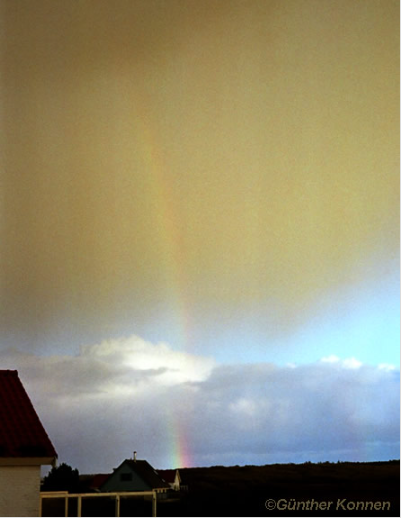Reflection Rainbow
The Reflection Rainbow: Unveiling its Enigmatic Beauty
Have you ever come across a peculiar rainbow that seemed to defy the laws of nature? One such mesmerizing sight is the reflection rainbow. This captivating phenomenon offers an extraordinary twist on the classic rainbow we are familiar with. While it may appear discontinuous and almost vertical, there is a hidden story behind its unique form.
Captured by Günther Konnen on the enchanting Dutch island of Terschelling, this photograph unveils the intricate details of the reflection rainbow. Taken in the late afternoon of November 18, '05, when the sun was merely 4° high, this image presents an awe-inspiring spectacle that goes beyond what meets the eye.
The reflection bow consists of two distinct parts. The upper section is known as the reflection bow itself, while the lower fragment is the normal primary bow. Let's dive deeper into the explanation of this extraordinary phenomenon.
The upper part of the reflection bow is formed through the process of reflection. In this instance, sunlight is reflected off a small lake located approximately 200 meters across and 1100 meters away from the camera. The reflected rays, as if originating from a sun shining 4° below the horizon, converge to create the towering appearance of the reflection bow. It's as if nature has crafted a mirage-like effect in the sky.
On the other hand, the lower stubby fragment represents the normal primary bow. In this case, a cloud had obstructed direct sunlight from reaching the raindrops in front of the camera. Consequently, only a portion of the primary bow is visible, leaving us in awe of its truncated form. This combination of the reflection bow and the truncated primary bow presents a truly unique sight that captures the imagination.
Interestingly, just before this remarkable image was taken, both the reflection bow and the normal rainbow were visible together. However, by the time Günther Konnen retrieved his camera, the normal rainbow had vanished. The direct sunlight was obstructed by a cloud, preventing it from illuminating the raindrops in the shower. Nonetheless, the reflection of the sun continued to cast its enchanting glow on the raindrops, resulting in this captivating visual masterpiece.
While the primary and reflection bows steal the show, there is more to behold in this photograph. On the right side, we can discern a faint secondary fragment and perhaps even a hint of the secondary reflection bow. These additional elements add an extra layer of complexity and beauty to an already mesmerizing scene.
The reflection rainbow captured by Günther Konnen is just one example of this awe-inspiring atmospheric phenomenon. In fact, there are countless other instances where reflection bows have been observed, each with its own unique characteristics and allure. These captivating optical phenomena remind us of the intricate wonders that nature has to offer, constantly surprising us with its perplexing beauty.
In conclusion, the reflection rainbow stands as a testament to the marvels of atmospheric optics. Its unconventional form and intriguing combination of reflection and primary bows leave us captivated and in awe of the world around us. As we continue to explore and unravel the mysteries of atmospheric phenomena, let us cherish these moments that remind us of the boundless beauty that surrounds us every day.

There is (literally) more to this odd looking bow than meets the eye.
It was taken by Günther Konnen on the Dutch island of Terschelling late on the afternoon of November 18, ’05. The sun was only 4° high.
What is the apparently discontinuous and almost vertical bow, part of which even curves inwards to the left? The upper part is a reflection bow. Sunlight was reflecting off a small lake about 200m across and 1100m from the camera. The upward going reflected rays, as though from a sun shining 4° below the horizon, formed the tall bow.
The lower stubby fragment is the normal primary bow. The remainder of the primary is not visible because a cloud had blocked the direct sunlight from shining on the raindrops in front of the camera. “Just before this picture was taken, I saw the reflection bow and the normal rainbow together. By the time I had got my camera, the normal rainbow was gone. A cloud had blocked the direct sunlight to the rain shower. The reflection of the sun was still illuminating the raindrops via a path under the cloud. This is the result.”
To the right is a faint secondary fragment and perhaps a hint of the secondary reflection bow.
More reflection bows 1,2,3,4.
©Günther Konnen, shown with permission.
Note: this article has been automatically converted from the old site and may not appear as intended. You can find the original article here.
Reference Atmospheric Optics
If you use any of the definitions, information, or data presented on Atmospheric Optics, please copy the link or reference below to properly credit us as the reference source. Thank you!
-
<a href="https://atoptics.co.uk/blog/reflection-rainbow-2/">Reflection Rainbow</a>
-
"Reflection Rainbow". Atmospheric Optics. Accessed on November 22, 2024. https://atoptics.co.uk/blog/reflection-rainbow-2/.
-
"Reflection Rainbow". Atmospheric Optics, https://atoptics.co.uk/blog/reflection-rainbow-2/. Accessed 22 November, 2024
-
Reflection Rainbow. Atmospheric Optics. Retrieved from https://atoptics.co.uk/blog/reflection-rainbow-2/.